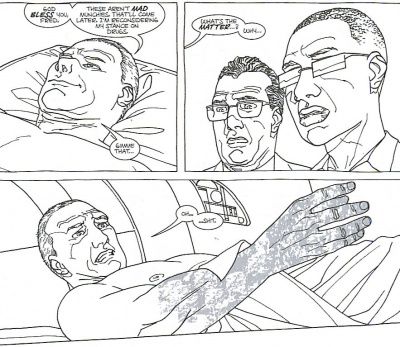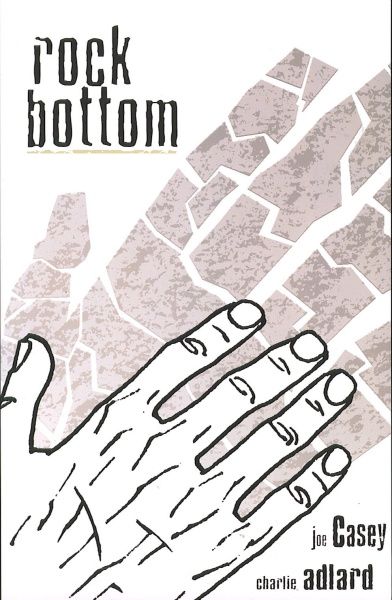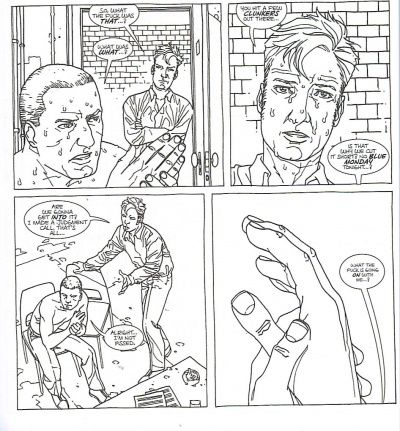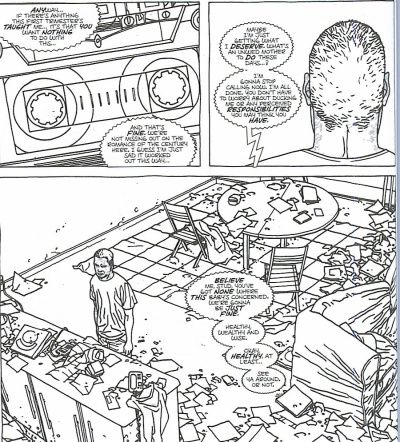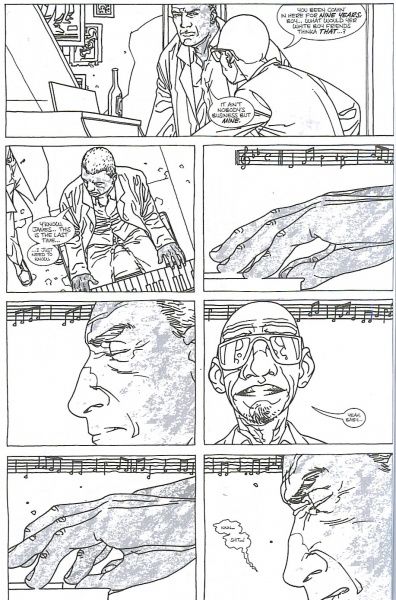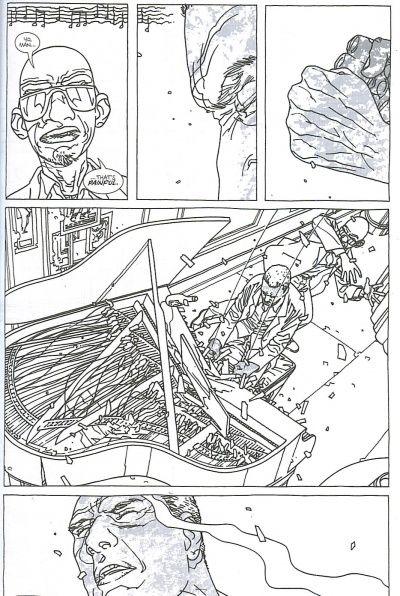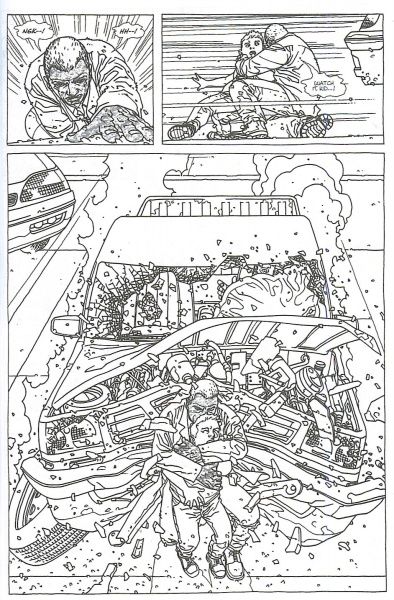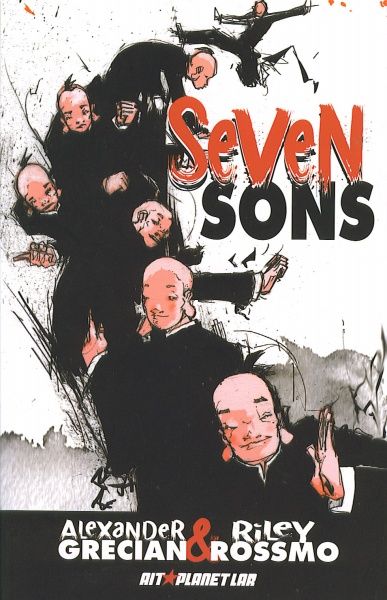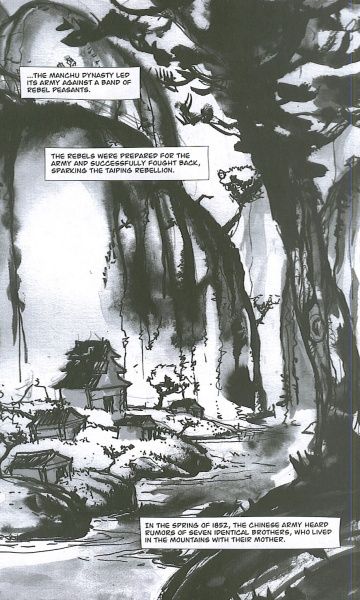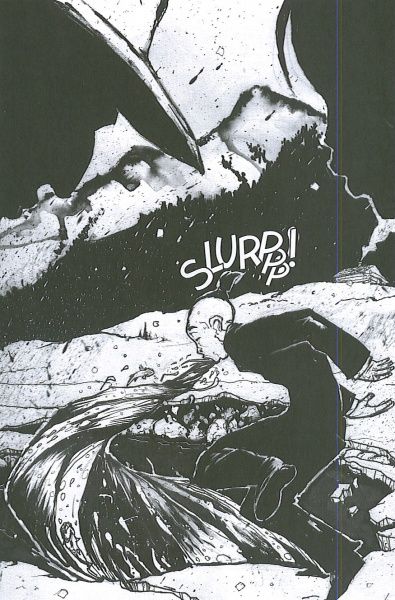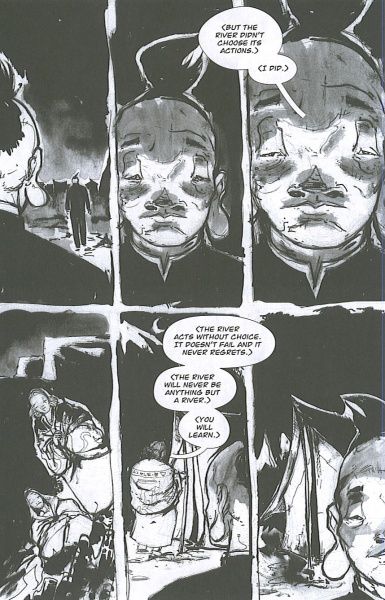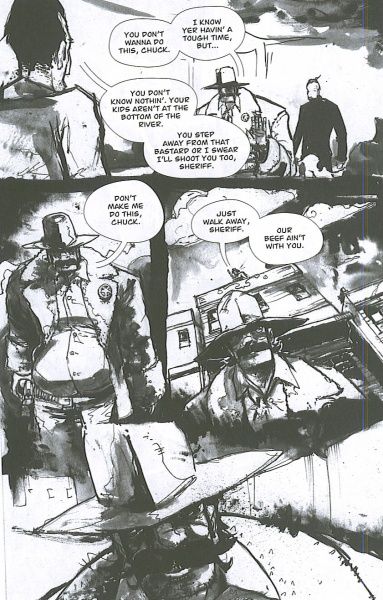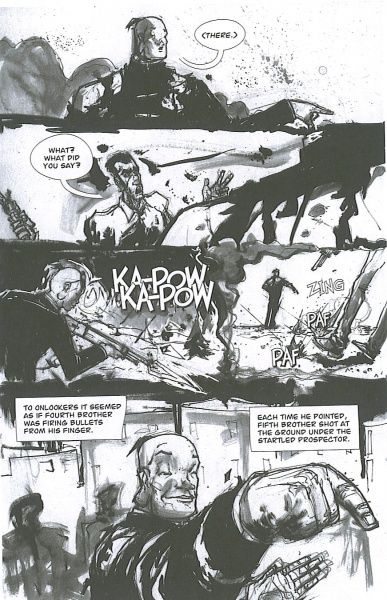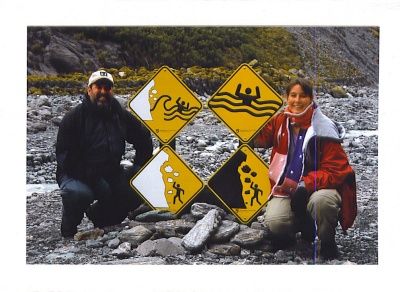With all the Seven Soldiers stuff I've been doing recently, I haven't had a chance to review a bunch of graphic novels I've read recently. These are comics that aren't from the Big Two and might have flown under your radar. Hence the name! I have a few of these to get through, so I thought I'd break them up into a few different posts. We'll begin with two, two, two! offerings from that Master of Marketing, Larry Young, and AiT/Planet Lar. He's crazy-insane that way!
Rock Bottom by Joe Casey and Charlie Adlard. Cost to you: 1,295 pennies.
Neither of these gentlemen gets the credit they deserve in the comics world. Adlard is a wonderful artist, with great attention to detail, a beautifully realistic style, and a subtle dyamism that is not as flashy as some others, but is still thrilling to look at. Casey, meanwhile, is simply one of the best writers working today. I have drooled over Gødland every time it comes out, and before that, two volumes of Wildcats and Automatic Kafka. Even The Intimates was pretty good! So this should be a slam dunk, right? Right?
Well, it's not bad. The biggest problem I have with it is that it never surprises you. Rock Bottom is the story of a man who turns to stone. No, that's not a metaphor. Thomas Dare literally turns to stone. That's pretty much it. Now, there's more going on, but essentially, we simply watch a man turn to stone. Tom Dare is kind of jerk, too, and therefore it's hard to really care about his plight. Halfway through the book, he accidentally becomes a hero, and although that makes his situation a bit more interesting, we still don't get so emotionally involved with him that we really care all that much. And that's too bad.
What did I want from the book? I'm not sure. Tom Dare is getting divorced at the beginning of the book, and from his words and actions, he probably deserves it. He plays piano in a band, which adds a bit of pathos to his illness, because piano is the only thing, it seems, that gives him joy. He starts to get chest pains and he can't move, and as he goes to the doctor over and over, everyone figures out that he is, indeed, becoming stone. Nobody knows how it happens or why it happens, although they figure out that his father died of the same thing, so it's genetic. Of course, he got a woman pregnant, so he has to deal with that, but he's still a jerk about it. When he rescues a kid who is about to be run down by a car, he and his doctor become celebrities, but that doesn't matter because he's still dying. As his celebrity grows, the hospital gains a vested interest in his fate, because they are footing the bill in the hopes that Tom Dare will bring them good publicity. He makes arrangements for his body, and there's a bit of tension when his wishes and those of the hospital's, but it all works out in the end. Well, except for the fact that Tom Dare, you know, dies (sorry for spoiling that, but it's pretty evident early on that there will be no last-minute rescue, and the book's not really about that anyway).
As I mentioned, it's not a bad book. Casey is making some points about the nature of heroism and celebrity, but it's nothing that we couldn't have figured it out already. And Tom Dare's "transformation" from jerk to decent guy is colored by the fact that he's dying. Everyone gets nicer when they're dying - well, not everybody, but that's what we think. This might have been more interesting if Dare had remained a total jerk throughout, because his change of heart feels false. The only thing that is strange about this book is that Dare turns to stone, which is a bit of a heavy-handed metaphor and some forced irony. So I'm not entirely sure what Casey is trying to say that's in any way new.
It's a very nice book to look at. Adlard's art is magnificent even in a mundane setting, and the way he draws Dare and the way he colors him (the book is in black and white with "tones" by Adlard and Paul Peart) makes us feel him getting heavier. It's fascinating to watch as he slowly loses his humanity. Adlard's art almost makes the book worth it.
Almost. I can't really recommend the book, even though it's not terrible. It's a neat idea, but Casey never really goes anywhere with it. Last year he gave us Full Moon Fever, which wasn't perfect but crackled with manic energy. This book doesn't even give us that. It's a shame, because I really do think Casey is a great writer. But not here.
Seven Sons by Alexander Grecian and Riley Rossmo. Cost to you: Another 1,295pennies!
On the other hand, Seven Sons is a hoot. It's a retelling of the Seven Chinese Brothers legend, but updated to America (fret not - they're still Chinese). It's a good idea, actually - Grecian uses the backdrop of the Taiping Rebellion in the 1850s (which was a really weird religious movement as well as a civil war) and the gold rush in California at the same time to illuminate not only the (unjustified) anger toward the brothers, but the racism against the "coolies" in the West during the frontier days (technically, the Brothers aren't coolies, but the comparison still works).
It begins in the modern day, providing a framing episode that is important, though not essential, to the story. An old Chinese man who owns what appear to be a pawn shop catches a young girl who has been painting graffiti on his side wall reading about the Seven Chinese Brothers in a book, and he tells her the "true" story. The brothers and their mother come to America to escape the Taiping Rebellion, and when they arrive in California, they try to stay out of everyone's way. One winter, though, some kids fall in the ice on the river, so the brother who can swallow the whole ocean sucks up the water to allow the miners to get the kids. They're slow, though, and he can't hold his breath long enough, and everyone dies. So the townspeople, of course, want revenge.
Of course, they don't know that there are seven brothers, because they're identical (in this version, this is a nice riff on the idea that racists think everyone who's not, say, white "all look alike"), and as each one tries to reason with them in different ways, they exhibit their special abilities and resist the violence done to them. The sheriff of the town proves to be reasonable, but even he can't stop the cycle of violence that has begun. It's fascinating, because even as we can tell a tragedy is coming, when it happens, it's still tragic, and what happens afterward is even worse. But I don't want to give too much away.
What Grecian does nicely in this book is give us a sense of what it was like for immigrants to this country, and he links this, subtly, to the immigrant experience even today. These are people who come to this country and just want to work and be left alone, and when one of them tries to do something good, it backfires. The townspeople, we feel, get angry not because First Brother failed to hold the water, but because he's Chinese, and therefore, of course he was going to fail. They fail to see that he tried to help, because they can't see past their prejudice. We understand their despair, and even feel the need to blame someone, but it quickly morphs into a hatred of the race, not the act or even the person. It's interesting to see how deftly Grecian shows how quickly things can change to racism. At first, we understand the anger of the townspeople, even though we know it's misplaced. Then, when that anger turns to racism, it's more repugnant to us, and it's very effective.
Rossmo's art is beautiful, as well. He does a nice job contrasting the Chinese Brothers, who are somewhat fastidious, with the rough-and-tumble Americans. This contrast shows the nice divide between an ancient culture and one just finding its way. The scenes of horror at the end are nicely done, too - the faces of the settlers are twisted with hatred, and the faces of the Brothers change to sadness from bewilderment at the Americans' anger. It's a nice book to look at, and it helps the story move along nicely.
This is a very good book. Grecian and Rossmo have taken an old legend and used it for their own purposes, which is why legends are fun - they're infinitely malleable. And it has a nice text piece in the back about the legend itself.
You can buy Rock Bottom here, if it sounds like your cup of tea. Seven Sons is available here. My thanks, as usual, to Larry for sending these to me (I already had Rock Bottom, so now I have two - which means I sense a contest coming soon in the new year). Larry is cool like that. Plus, he sent me a Christmas card from (I assume) their time in New Zealand. Now this is a dangerous place to hang out:
I miss New Zealand.
In Part 2, I will look at some very weird books. Seriously. Really, really weird. I'll get to them at some point!

